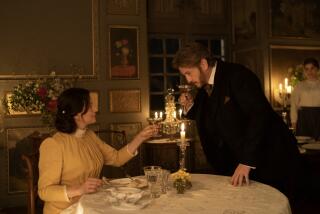That Austrian Woman
- Share via
On the day that 14-year-old Maria Antonia of Austria became Marie Antoinette of France, she arrived at a small island in the Rhine River on the border of those two countries. The island, neither French nor Austrian, seemed a fitting spot for the ceremony at hand. In full view of those in attendance--including a 300-person entourage that had come with her from Austria, carried by 57 coaches and 10,000 horses--Maria Antonia was stripped of her Austrian-made wedding clothes, dressed in appropriate French attire and handed over to the French.
As Antonia Fraser tells us in her new biography, “Marie Antoinette: The Journey,” this deliberate rite was an “act of possession,” symbolic of the transforming of an archduchess of Austria into a princess of France. Marie Antoinette was a human peace offering, sent to seal the Treaty of Versailles, signed 14 years earlier in 1756, uniting France and Austria, traditional enemies, in a defensive pact against Prussia. “From the first,” Fraser writes, “Madame Antoine had her value, not as an individual, but as a piece on her mother’s chessboard.” Marie Antoinette’s bridegroom was Louis Augustus, crown prince of France, who would become Louis XVI.
The May 1770 ceremony along the Rhine was full of the pomp and circumstance that marked all of the wedding festivities. Yet it failed to substantiate Marie Antoinette’s renouncement of her motherland. Although Marie Antoinette had grown up speaking French in the Austrian court and could claim more French heritage than her husband, the dauphin, she would be plagued all her life with a label that was meant to be as ugly as it sounds in French: l’Autrichienne. The Austrian woman.
From Princess Grace to Princess Diana, from the Romanovs to the Kennedys, we have long been fascinated by royal lives sadly abbreviated. Marie Antoinette’s is no exception. Almost 250 years after her birth in 1755, the story of Marie Antoinette captures our imagination still. What has rendered it so dramatic, so worthy of our interest, is not its beginning or its middle but rather its end.
Reading any biography of the queen, therefore, becomes an act of voyeurism as we await the royal beheading. Over the last two centuries, countless biographies have traveled this path. Recently, her story has been told in an A&E; biography; a young adults’ book; a scrapbook of anecdotes, drawings and pictures; and a more scholarly volume focusing on the vilification of the queen in the popular culture of her time.
Most books about her can be divided into two categories: those that render her a perpetrator responsible for her fate and those that show her as a victim of circumstances largely beyond her control. The truth is probably somewhere between these two. Either way, biographers almost always portray her as a two-dimensional figure, without much depth or self-awareness.
The Marie Antoinette who emerges from these pages is fully formed, a feat for which Fraser deserves much praise. That we find so much sympathy for a character who has so little in common with the travails of our own time is to Fraser’s credit too. She navigates the doublespeak and scurrilous journalism of the period with the skill of a master helmsman. Fraser researched at the Archives Nationales in Paris and the Hapsburg Archives in Vienna and found a remarkable number of eyewitness accounts of the queen’s life--from her daughter, Madame Royale, to people on the street. She synthesizes these sources with nearly every other book written about the queen into an often sympathetic portrait.
Fraser writes that she has attempted to tell the story of Marie Antoinette “without anticipating its terrible ending.” But the fate of the queen, indeed the fate of the French monarchy, lurks around every turn of this book.
Marie Antoinette arrived at the fabled court of Versailles in 1770. It was a world unlike any she had known before--replete with mistresses of kings and an intricate web of favoritism and prestige--where nothing could ever be kept secret. Marie Antoinette never knew that her letters to her mother were amended; the two men she trusted most, her advisor, Count Mercy d’Argenteau, and her tutor, the Abbe de Vermond, were as much spies for Austria as confidants of the queen of France. Even Louis XVI’s sexual dysfunction became a topic of court discussion.
Yet Marie Antoinette found her way. With porcelain-doll looks that blossomed under the effects of French clothing, makeup and ever-more elaborate hairstyles, she came to represent an epitome of royal beauty. Within months, she had recognized how to contend with Madame Du Barry, the mistress of her grandfather-in-law, Louis XV, without compromising her place as dauphine; more slowly, she managed to assert some influence over the rather intractable court.
At Petit Trianon, her country retreat within the walls of Versailles, simplicity reigned. Inspired by Jean-Jacques Rousseau, whose nature writings preceded his revolutionary works, Marie Antoinette built an elaborate but rustic village--complete with goats, cows, roosters and pigeons as well as a mole catcher, a cowherd and peasants who did the work that the queen and her ladies--who dressed in simple (but not inelegant) milkmaid-like dresses--preferred to avoid.
Marie Antoinette became a patron of the arts, supporting everyone from Christoph Gluck (who dedicated a series of operas to her) to Antonio Salieri. She staged plays, often taking part in the productions, at a theater she had installed near Trianon. The queen preferred characters who recalled a certain pastoral simplicity: “shepherdesses, village maidens and chambermaids,” writes Fraser.
But motherhood was Marie Antoinette’s greatest role. After struggling for more than seven years to get pregnant, the queen gave birth to her first child, Marie Therese Charlotte, who was called Madame Royale, in 1778; two boys followed. But their births failed to soften the hearts of the French citizenry toward l’Autrichienne.
Marie Antoinette’s already fragile credibility with the French began to unravel in 1784 with the onset of the strange Diamond Necklace Affair. In the midst of a worsening budget crisis, an elaborate plot was revealed in which the Comtesse Delamotte, disguising herself as Marie Antoinette, had procured the help of Cardinal de Rohan, who had fallen out of favor with the queen years earlier, to purchase an ornate necklace, made with 647 diamonds, that weighed 2,800 carats.The queen had refused to purchase the necklace (it was not her style and she was under pressure to control her usually outlandish spending), but Rohan did not know that. He helped the comtesse obtain the necklace; when he failed to make payments to the jeweler, the affair became public. The comtesse and Rohan were caught and tried. She was stripped naked, beaten in public, branded with the letter “V” (for voleuse, or thief) and sentenced to life in prison; he was levied a fine and removed from office but escaped a prison sentence. Freeing the cardinal “was the most damning denunciation of the Queen’s way of life.”
The scandal further undermined the credibility of Marie Antoinette, long known for her extravagance and frivolity. Her enemies suggested that the queen had either schemed to ruin the cardinal or used her influence and sexuality to obtain the extraordinary necklace without paying for it. “[I]t was by implication a legitimate assumption,” writes Fraser. The queen learned from the affair; it “brought new steel to a fundamentally pliant character,” according to Fraser.
Louis XVI was a largely ineffective and inattentive monarch who had little sense of his place in history; on July 14, 1789, the day of the storming of the Bastille, he wrote the word rien --nothing--in his journal. Until his family was placed under house arrest and stripped of their royal titles, the king seemed unaware of the significance of the life-altering events happening around him.
Yet Marie Antoinette was the real object of French scorn. “She was a queen they hated, whom it was safe to scorn where public derision for the King was still a step too far,” writes Fraser.
Pamphlets, songs and poems, almost universally vulgar, seemed to replicate with alarming frequency misinformation about the queen, including that famous phrase--”Let them eat cake ( Qu’ils mangent de la brioche).” Although Fraser does not identify the origin of this most famous rumor (though many have attributed it to Rousseau), she is confident that it was never uttered by the queen.
After the royal family was placed under house arrest, Marie Antoinette became an even more potent lightning rod for the revolutionaries’ wrath. The family attempted to escape once, trying to reach the French-Austrian border, in 1791, and was almost successful; yet their escape and its failure were blamed on the queen. She was taken back to Paris as a trophy, Fraser writes. “Marie Antoinette had no reputation left to lose;
The queen was eventually put on trial for high treason, accused of moral turpitude and of encouraging her husband to value Austria over France. The revolutionary tribunal sentenced her to die on the guillotine the next day. Eyewitnesses report that the 37-year-old went to her fate without histrionics. “I am calm,” she wrote on her last night, “as people are whose conscience is clear.”
After her death, the queen’s head was displayed aloft to what Fraser calls “a joyous public.” It was taken for burial to the cemetery. While the gravediggers lunched, they left it out on the grass long enough for Marie Grosholz--better known by her married name, Tussaud--to sculpt the queen’s likeness in wax. It was, by all accounts, an accurate portrait--though it would never be displayed in public.
Marie Antoinette “was a victim from birth,” writes Fraser in an informed, insightful epilogue about the queen. “Like her marriage, Marie Antoinette’s death was a political decision.” Fraser suggests that Marie Antoinette would have shone in the apolitical monarchies that dominated much of the 19th century. Instead, she was a casualty of the implosion of the 18th-century political system she had tried for so long to resist.
More to Read
Sign up for our Book Club newsletter
Get the latest news, events and more from the Los Angeles Times Book Club, and help us get L.A. reading and talking.
You may occasionally receive promotional content from the Los Angeles Times.










